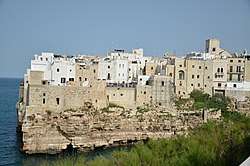Polignano a Mare
Polignano a Mare | |
|---|---|
| Comune di Polignano a Mare | |
 | |
| Coordinates: 41°00′N 17°13′E / 41.000°N 17.217°E | |
| Country | Italy |
| Region | Apulia |
| Metropolitan city | Bari (BA) |
| Frazioni | Casello Cavuzzi, Chiesa Nuova, San Vito and a part of Triggianello |
| Government | |
| • Mayor | Domenico Vitto |
| Area | |
• Total | 67 km2 (26 sq mi) |
| Elevation | 24 m (79 ft) |
| Population (1 January 2021)[2] | |
• Total | 17 491 |
| Demonym | Polignanesi |
| Time zone | UTC+1 (CET) |
| • Summer (DST) | UTC+2 (CEST) |
| Postal code | 70044 |
| Dialing code | 080 |
| Patron saint | St. Vitus |
| Saint day | June 15 |
| Website | Official website |
Polignano a Mare (Italian: [poliɲˈɲaːno a mˈmaːre]; Barese: Peghegnéne [pəɡəɲˈɲeːnə]) is a town and comune in the Metropolitan City of Bari, Apulia, southern Italy, located on the Adriatic Sea. The local economy mostly depends on tourism, agriculture and fishing.
History
The area has been settled since prehistoric times, evidenced by archaeological excavations in the locality of Santa Barbara. It is believed to be the site of the ancient Greek city of Neapolis of Apulia. Nowadays, some historians suggest that this latter was one of the two colonies founded during the IV century b.C. by Dionysius II of Syracuse; other sources, instead, claim Julius Caesar as the father of Polignano a Mare, which might have been a central hub along the well-known Via Traiana. Thanks to its strategic position on the Adriatic Sea, it soon became a trade centre, at least until the introduction of a Greek coin bearing the "NEAII" inscription.[3]
The foreign dominations led the town to a greater development and recognition. The Byzantine Empire, in the VI century, turned it into a municipal structure; subsequently, it was dominated by the Normans, who, during the XI century made the local economy thrive by boosting the production of the olive oil.[4]The fortification of the suburb, on the other hand, has plainly to be attributed to the Angioinians, who secured the protection of the land from potential threats including the Turkish army and the different kinds of epidemics.[5]
Under the Aragonese crown, Polignano reached its peak in both economic and cultural terms; this meant business men and merchants coming from different parts of the world meeting there soon afterwards.[6]
Places of interest
- Fondazione Museo "Pino Pascali"
- Palazzo dell'Orologio
- Abbey of San Vito Martire
- Church of Santa Maria Assunta
- Lama Monachile
Twin towns
 San Miniato, Italy
San Miniato, Italy Forio, Italy
Forio, Italy
References
- ^ "Superficie di Comuni Province e Regioni italiane al 9 ottobre 2011". Italian National Institute of Statistics. Retrieved 16 March 2019.
- ^ Population from Istat
- ^ Matarrese, Domenico. Polignano a Mare: guida storico-turistica.
- ^ Mariani, C. (1981). Insediamenti benedettini in Puglia.
- ^ Matarrese, Domenico. Polignano a Mare: guida storico-turistica.
- ^ L'Abbate, V. (1983). Il territorio a Sud-est di Bari in età medioevale.
External links
 Polignano a Mare travel guide from Wikivoyage
Polignano a Mare travel guide from Wikivoyage Media related to Polignano a Mare at Wikimedia Commons
Media related to Polignano a Mare at Wikimedia Commons- Official website
- Viaggiare in Puglia (Italian)
- ProLoco Polignano





